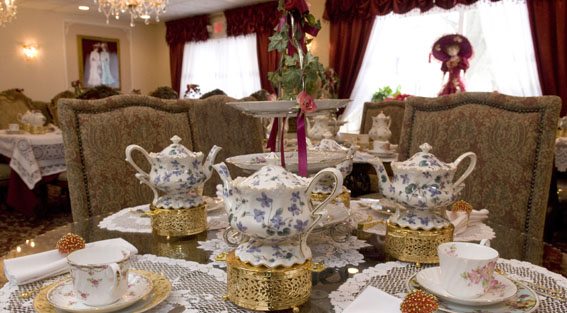Tea lovers are a special breed. They simply love drinking tea and are always seeking new flavors of tea and special tea houses that offer the elegant and unique High Tea experience. However, very few actually know the history of High Tea. In this article, Bon Appétit Tea House of Mahwah, New Jersey presents a brief history of High Tea.
Thousand of years ago tea drinking was widespread in China, and tea houses were a social and ceremonial meeting place. Tea was also used as currency and a trading commodity and was the most important export with Europe, Japan and India. Afternoon tea was served in France as early as the 1600's.
Tea-Time in England started during the early 1800’s. Lunch was typically offered at 11:30 am while dinner was served at 8:00 pm. The wait time between the meals left many people famished by suppertime. The Duchess of Bedford had a solution for her grumbling stomach: serve tea with bread, butter and cakes. She began inviting friends to join her. This became the 'in' thing for upper class women to serve Afternoon Tea, with lemon curd, scones, delicate sandwiches and sweets.
The tea ritual used the finest bone china, silver teaspoons and linens. Ladies began collecting individual teacups and pots and showed their collection creatively mismatched to give the event "personality".
Afternoon Tea then become a social tradition during the Victorian period and is still highly respected today.
Afternoon Tea and High Tea are two different types of events. Afternoon Tea, also known as "low tea", is usually taken in the late afternoon. It was called "low tea" because it was usually taken in a sitting room or drawing room where low tables (like a coffee table) were placed near sofas or chairs. There are three fundamental types of Afternoon Tea: Cream Tea (tea, scones, jam and cream) Light Tea (tea, scones, and sweets) Full Tea (tea, savories, scones, sweets and dessert).
High Tea, also referred to as "meat tea", is typically of a heavier consistency, such as adding soup and salad to the menu. Today, tea rooms serve a variety of tea courses purposely in this order: Scones (with jam and Devonshire or clotted cream), Savories (tiny sandwiches or/ and appetizers), soup, salad and pastries (cakes, cookies, desserts).
"There are few hours in life more agreeable than the hour dedicated to the ceremony known as afternoon tea." – Henry James












